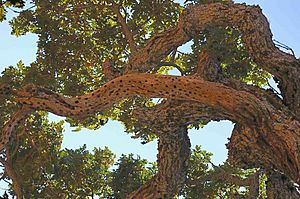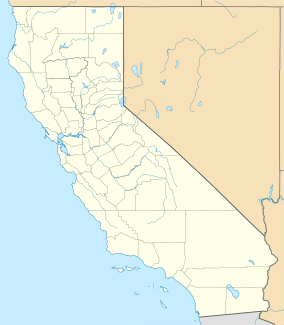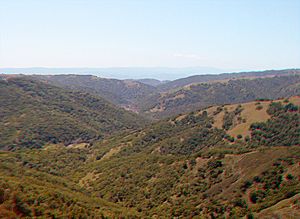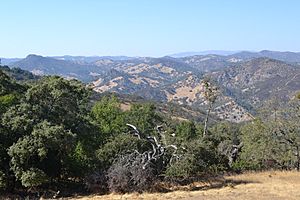Henry W. Coe State Park facts for kids
Quick facts for kids Henry W. Coe State Park |
|
|---|---|
|
IUCN Category Ib (Wilderness Area)
|
|

Ponderosa Pines on summit of Pine Ridge
|
|
| Location | Santa Clara and Stanislaus Counties, California, USA |
| Nearest city | Morgan Hill, California |
| Area | 87,000 acres (350 km2) |
| Established | 1959 |
| Visitors | 34,395 (in 2006) |
| Governing body | California Department of Parks and Recreation |
| Henry W. Coe State Wilderness (Orestimba Wilderness) | |
|---|---|
| Location | Santa Clara and Stanislaus Counties, California, USA |
| Nearest city | Morgan Hill, California |
| Area | 22,000 acres (89 km2) |
| Established | 1985 |
| Governing body | California Department of Parks & Recreation |
Henry W. Coe State Park, often called Henry Coe or Coe Park, is a huge state park in California, USA. It protects a large part of the Diablo Range mountains. The park is near Morgan Hill and spans both Santa Clara and Stanislaus counties.
With over 87,000 acres (35,000 ha) of land, it is the biggest state park in northern California. It's also the second-largest in the whole state, after Anza-Borrego Desert State Park. Inside the park, there's a special protected area called the Henry W. Coe State Wilderness. People also call it the Orestimba Wilderness. This wilderness area is about 22,000 acres (8,900 ha) in size. The park was officially created in 1959.
Contents
Discovering Henry Coe State Park's Past
Early Trails and Ranch Life
Before it became a park, the land was used as a ranch. Long ago, a trail called La Vereda del Monte crossed this area. People used this trail to move horses between the Sacramento River Delta and the San Joaquin Valley. Horses were kept in places now inside the park, like Valle Atravesado (now Mississippi Lake), Valle Hondo, and Paradise Flat. The names Mustang Peak and Mustang Flat come from these horse-moving activities.
The park started as a private cattle ranch called Pine Ridge Ranch. It belonged to Henry Willard Coe, Jr. and his family from 1905 until 1943. After his death, his daughter, Sada Coe Robinson, bought the ranch back in 1950. She then gave it to Santa Clara County in 1953, and it became Henry Willard Coe County Park. In 1958, it officially became a state park.
How the Park Grew
For many years, the park was about 13,000 acres (5,300 ha). But in the early 1980s, the park grew much larger. More land was bought, making it about 67,000 acres (27,000 ha). In the early 1990s, even more land was added, bringing the total to about 11,000 acres (4,500 ha) more. The park is still growing today!
The Lick Fire of 2007
In 2007, a very large wildfire swept through the northern part of the park. It was called the Lick Fire. The fire started on September 3 and quickly grew. By September 11, it had burned about 47,760 acres (19,330 ha). Fire officials said the fire started from burning debris outside the park. The person responsible for starting the fire had to pay for the damage. All areas affected by the fire were reopened to visitors in February 2008.
Exploring Henry Coe's Geography
Henry W. Coe State Park is in the Diablo Range mountains. It is east of Morgan Hill, California. The park has many high ridges separated by deep canyons. There are also some flat valley bottoms and distinct peaks. Most ridges are between 2,000 to 3,000 feet (610 to 910 m) high. The canyon bottoms are usually around 1,000 to 1,500 feet (300 to 460 m) above sea level.
The highest point in the park is about 3,560 feet (1,090 m) high. This spot is near Mount Stakes, which is the highest point in Stanislaus County. The lowest point in the main part of the park is where the North Fork of Pacheco Creek flows out. This is about 710 feet (220 m) high.
Major Ridges and Peaks
The park has many important ridges and peaks. Some of these include:
- Pine Ridge
- Middle Ridge
- Blue Ridge (with Mount Sizer as its highest point)
- Rock House Ridge
- Bear Mountain
- Robison Mountain
- Rooster Comb
- Mahoney Ridge
- Pacheco Ridge
- Mustang Peak
- Burra Burra Peak
The park is divided into 13 zones on the official map. These zones help visitors understand the different areas of the park.
Waterways and Lakes
The park includes parts of three main river systems: Coyote Creek, Orestimba Creek, and Pacheco Creek. Coyote Creek flows north towards San Jose and into the San Francisco Bay. The South Fork Orestimba Creek flows east to the San Joaquin Valley. The North Fork Pacheco Creek flows west, eventually reaching Monterey Bay.
All the creeks in the park are seasonal. This means they do not flow all year round. They usually flow from November to May, depending on the rain. After heavy rain, the creeks can become very strong.
The park also has many reservoirs. These were built by the old ranch owners for cattle and for fishing. The largest is Mississippi Lake, which is about 32 acres (13 ha) big. Other notable lakes include Coit, Kelly, Jackrabbit, and Paradise lakes.
Henry Coe's Natural World
The park protects a special type of environment called California interior chaparral and woodlands. Large areas of the park are covered in chaparral and oak woodlands.
Plant Life

Henry Coe State Park is special because its plant life is mostly natural. You won't find many non-native trees or shrubs here. The park has forests on ridge-tops and slopes, mixed with chaparral and grasslands. Some creeks also have unique plants that grow near water.
Common native trees in the park include:
- Valley oak (Quercus lobata)
- Blue oak (Q. douglasii)
- Coast live oak (Q. agrifolia)
- Gray pine (Pinus sabiniana)
- Ponderosa pine (P. ponderosa)
- Pacific madrone (Arbutus menziesii)
- California buckeye (Aesculus californica)
Some Big-berry Manzanita trees in the park can grow very tall, over 20 feet (6 m)! The chamise (Adenostoma fasciculatum) shrub is very common. It covers many hot, dry slopes.
Blue oak is the most common tree in the park. It is especially noticeable on the eastern side. Gray pine is also found almost everywhere. Ponderosa pines grow on parts of Pine, Middle, and Blue ridges. They are often found on the cooler, higher parts of the mountains.
Animal Life
The park is home to many different animals. Large mammals you might see include:
- Black-tailed deer
- Tule elk
- Wild pig (not native to the area)
- Coyote
- Bobcat
- Mountain lion (also called cougar or puma)
Smaller mammals living here include raccoons, gray foxes, and Beechey ground squirrels.
About 170 types of birds have been seen in the park. Some common birds are:
- Red-tailed hawk
- Golden eagle
- Turkey vulture
- Raven
- Acorn woodpecker
- California quail
- Wild turkey (not native)
You might also spot reptiles like western fence lizards, Pacific gopher snakes, and western rattlesnakes. Common amphibians include Pacific tree frogs and California newts.
Park Facilities and Access
Henry Coe State Park has a few facilities for visitors. The main area is at Coe Headquarters. This is where the historic Pine Ridge Ranch used to be. Here you'll find:
- A visitor center with exhibits about ranch life.
- A small bookstore.
- An information desk.
- A campground with 20 spots for tents and small recreational vehicles.
- A horse camp with paddocks and water for horses.
This area is at the end of East Dunne Avenue, about 14 miles (23 km) east of Morgan Hill.
Other Access Points
- Hunting Hollow: This parking area is off Gilroy Hot Springs Road. It's more basic, with only a chemical toilet and no piped water. It's great for easy walks and biking on a flat trail.
- Coyote Creek: About 2 miles (3.2 km) north on Gilroy Hot Springs Road. There's no parking here, so you need to be dropped off or walk from Hunting Hollow.
- Dowdy Ranch Visitor's Center: This entrance opened in 2007. You can reach it by an unpaved road from Bell Station on State Route 152. It's usually open on weekends during the dry summer season.
Many water sources are found throughout the park, like seasonal springs and old ponds. It's important to filter any surface water before drinking it. The park also has clean, wheelchair-friendly toilets.
Fun Activities at Henry Coe

Most visitors to Henry Coe State Park enjoy hiking or mountain biking on the many trails. The park has about 200 miles (320 km) of dirt roads and trails. Some roads are wide, while others are narrow and can be overgrown. Newer trails are usually well-maintained.
Backpacking Adventures
Henry Coe is an amazing place for backpacking. The park is so big that you can plan long trips. You could hike ten miles a day and stay at a different campsite each night for two weeks without using the same trail twice! This is unique for parks in the San Francisco Bay Area. Backpackers can also fish in several lakes that have bass and bluegill. Mississippi Lake, Coit Lake, and Kelly Lake are popular fishing spots. You need a permit, but they are usually easy to get.
Biking and Horseback Riding
Mountain biking is very popular at the park. Only a few miles of trails are off-limits to bikes. Horseback riders also use the trails. Hunting is not allowed in the park, but fishing is. Motorized vehicles are not allowed in the backcountry, except for park staff.
Best Times to Visit
Spring is the most popular time to visit Henry Coe. The weather is mild, the hills are green, and wildflowers are blooming. The creeks also flow well in spring. Summer can be very hot and dry, but the nights are pleasant for stargazing. Fall, from mid-October to early November, is also a nice time to visit. Even in winter, there are mild days between rainstorms. Sometimes, it snows lightly, but it usually melts quickly.
Safety Tips
The most common danger for visitors is getting tired from hiking or biking too much. Make sure to bring enough water and food. There are also many ticks in the park, so check yourself after your visit. You might also see a few rattlesnakes, so be aware of your surroundings.
Park Events
The Pine Ridge Association, a group that supports the park, hosts two popular events each year:
- Mothers' Day Breakfast: A special breakfast event.
- TarantulaFest: Held in the fall, this event celebrates the gentle tarantulas that live in the park. You can often see male tarantulas wandering around during this time. It includes a barbecue and live music.
Protecting Henry W. Coe State Park
Henry W. Coe State Park has faced threats of closure in the past. In 2012, it was one of 70 California state parks that might have closed due to budget cuts. However, park supporters from the San Jose and Silicon Valley area created the Coe Park Preservation Fund. They raised money to keep the park open and staffed. A major donor, J. Daniel McCranie, helped keep the park running until June 2015.
The park was also threatened with closure in 2008 and 2009. But these closures were avoided by reducing hours and maintenance across the state park system. Thanks to community support, Henry W. Coe State Park remains open for everyone to enjoy.





